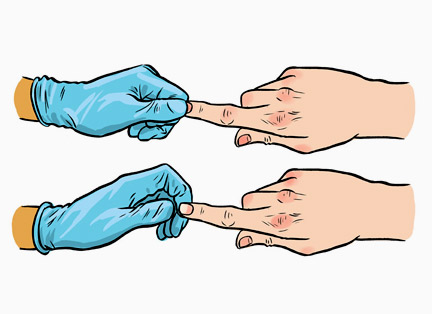Manifestations, Tests, and Therapies: Clinical Case Study
Common Manifestations, Tests, and Therapies of GI Disorders |
|
HPI: HD is a 32-year-old male who presents to your clinic with a 4-day history of diarrhea (see Figure 1). He reports large volumes of watery diarrhea and abdominal cramping that has been progressing over the 4-day period. He denies blood or mucus in the stool. He denies fever, but has had increased thirst, despite being unable to hold down any food or fluids for the past 24 hours. HD reports that he had a seafood dinner with a friend 6 days ago and that friend is reporting similar symptoms. PMI: HD has been healthy, without previous GI disturbances. He is not on any current medications. P/E: HD appears tired but is in not apparent distress. Vitals: HR 96; BP 109/73 mm Hg; RR 16; T 36.7°C (98°F); SaO2 96% on room air. Head and neck examination reveals dry mucous membranes. Chest examination is unremarkable. Abdominal examination reveals generalized discomfort, but nor localized pain. There is no evidence of guarding or rebound tenderness. Periphery is slightly cool, with cap refill of 3 seconds (see technique, Figure 2). |
|
| Question | Your Answer |
What is the most likely diagnosis? |
Gastroenteritis—likely secondary to bacteria from seafood dinner. |
Why is HD’s heart rate elevated? |
While not tachycardic (by definition it’s HR >100 bpm), HD’s heart rate is high from relative hypovolemia. He has been losing significant amounts of water through diarrhea and is unable to replenish them orally. |
What is the best investigation plan for this patient? |
Often, diagnosing infectious gastroenteritis is done through the history and ruling out more serious concerns; e.g., appendicitis. Checking blood counts and electrolytes is often appropriate if the symptoms have been severe or long lasting. |
Should this patient receive antibiotics? |
Antibiotics are rarely indicated for gastroenteritis, even bacterial. This is because most episodes are self-limited, and treatment with antibiotics can lead to carrier states in some cases or to Clostridium difficile infection. Most patients don’t require any treatment other than oral rehydration (small amounts of fluids, frequently). For more concerning cases, treatment with intravenous fluids, and correction of electrolyte imbalances may be appropriate. |
What does capillary refill of 3 seconds indicate? |
Capillary refill is an indicator of peripheral circulation. As would be expected with this patient (mild-moderate hypovolemia), his peripheral perfusion is reduced and therefore cap refill delayed (normal is < 3 seconds) |
What is the primary action of loperamide (Imodium)? |
Loperamide is an antidiarrheal medication that works by decreasing intestinal motility, thus providing greater time for water resorption in the large bowel. |

